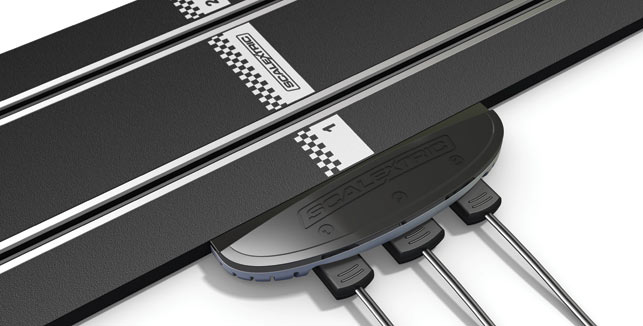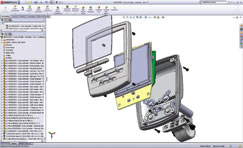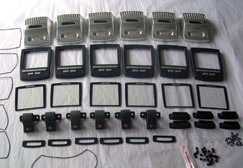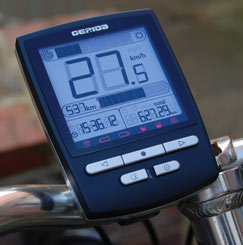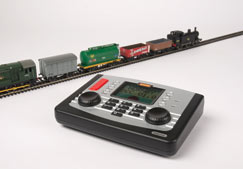For a design consultancy with such a vast and varied international client base it’s amazing that Product Resolutions works out of a small studio located in Norwich’s city centre.
With only a handful of computers and not a single piece of prototyping equipment or machine tool in sight the firm undertakes the full design and development of dozens of products each year.

Product Resolutions worked on the recently launched Scalextric Start system
Its business model combines in-house design skills with the technical and manufacturing expertise of Chinese suppliers in order to create commercially successful new products. “Our unique approach as a design consultancy is to consider every aspect of bringing a product to market: covering not only function and aesthetics, but also ease of manufacture and product profitability,” explains Product Resolution’s director, Nick Harvey.
Fellow director, Paul Robbins, lived and worked in Hong Kong and China for seven years prior to setting up Product Resolutions in 2000. It was when he was working at the first independent western design consultancy to be set up in Hong Kong, which was helping UK companies looking to manufacture in China, that he saw the opportunity of doing exactly that, but from the UK.
He felt that he could establish a UK design business that would really set itself apart as a consultancy that had a fresh approach to creating new products. “I saw the opportunity to have all the creativity and innovation that is associated with UK design but present it so that it is ready for manufacture,” he explains. “So, it would take into account the cost constraints in terms of tooling but also the engineering of the product so that it fits with Chinese manufacturing.
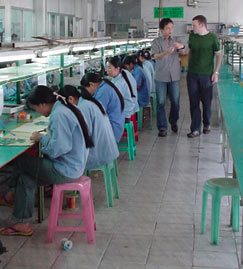
Product Resolution’s director, Nick Harvey visiting a supplier factory in China
“Our approach in terms of combining the creativity but with the technical knowledge has always been our USP. Even now many design consultancies say that they can work in China but it’s often nearly always through a joint venture or agency set up, whereas we talk directly to Chinese factories and suppliers every day,” he adds.
Celebrating its tenth anniversary this year, the company has designed and developed a wide range of products from consumer electronics and medical devices to toys and cycling accessories for a variety of clients, which also include lone inventors who need assistance in both developing their ideas and sourcing manufacturing.
As Product Resolutions is capable of managing an entire project from the very beginning right to the very end, they tend to fit well with a certain type of business who requires them to work on a project from concept through to a minimum of production level data.
“We have quite an influence on our client’s design process,” says Robbins. “We especially tend to fit well with businesses that haven’t used design before.”
For instance, Product Resolutions has been working with Lumie, a European specialist in light therapy, for seven years and with each project is involved from initial concept stage right through to manufacturing liaison. Hornby is also a long-term client and although it has its own in-house design resource, its team enjoys working with Product Resolutions.
Hornby not only finds the Norwich firm to be very in tune with the commercial realities of mass production but also believes that its designs are innovative and straightforward to manufacture. Projects that Product Resolutions has worked on for Hornby include the Digital Command Control system for trains and the newly launched Scalextric Start system.
From concept to development
Over the years Product Resolutions has refined a product design process that includes all the vital stages required to produce a successful design. Although, in theory, everything should run smoothly, according to Harvey, depending on the client and what they are designing for them, it very often deviates.
All projects begin with a brief, which, depending on the project, is followed by research and then a 2D concept design phase that in most instances involves presenting the client with three concepts to choose from.
The next stage is to move into 3D and produce a CAD model, including the mechanical design, using SolidWorks.
Being a small team Product Resolutions feels that being able to do mechanical design in-house is very important. “
A lot of the fine tuning of a design happens at this stage and if there is an alteration to the design because a component gets changed we want to be in control of that,” explains Robbins. “So we go from sketching up concepts to drafting up screw posts and that is part of the enjoyment of the process as well.” From then on in the process China features quite heavily as most of the prototyping, tooling and manufacturing is done using Chinese suppliers and toolmakers.
The Road to China
The recent development of a controller for an electric bicycle for Hungarian company Gepida, through its UK client GPEG, perfectly showcases Product Resolutions’ ability to work efficiently with its Chinese suppliers. However, the start of this project was slightly unusual in that the consultancy received a basic CAD concept model from the client and was tasked with redesigning it so that it could be manufactured efficiently and cost-effectively. This involved not only mechanical design but also defining the PCBs and ensuring that the product would pass the IP56 waterproof rating.
From the design multiple prototypes were then made and the Chinese toolmaker produced the tooling, which involved die-casting and injection moulding. As Gepida had to have twenty prototypes ready for a bike show, the timeline for this project was very tight and Product Resolutions had three months from the start to having tooling made. “On a product like this the design process might be six to eight weeks and then tooling takes five weeks which is pretty good,” comments Robbins.
Although Product Resolutions does use UK prototyping companies including Paragon Rapid Technologies and Laser Prototypes, 90 per cent of its prototypes are made in China.
In the case of the Gepida product it knew that the Chinese supplier could use CNC machines to produce the parts needed from polycarbonate and aluminium as well as doing silk-screen printing. It could also deliver it in just five working days for a very good cost. “But it’s not just about the cost,” says Harvey, “the quality is really excellent especially as there was a lot of waterproofing issues to consider in the bicycle controller product. The prototypes are so good that you can’t tell them apart from the real thing.”
The tooling for the GPEG project was also made in China, which included die cast moulds, composite parts for the brackets, injection moulded parts and even to the point of helping to source cable lead manufacturers.
Although many UK companies find it difficult to work with Chinese manufacturing partners, according to Harvey, for them it’s a bit of a black art. It’s not so much about Robbins being able to speak Cantonese, something he learnt whilst living there, but it’s also about respecting what the toolmakers and factories do and understanding what they are good at and how they like to work.
“I wouldn’t deal with a non-English speaking factory because that would be too difficult but the suppliers we use we have known for a long time and it’s to do with the way you speak to them and how you give them information,” says Robbins.
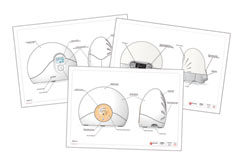
Concept sketches of the Lumie Starter, a light emitting alarm product: Product Resolutions typically presents the client with three concepts to choose from
Communication is mostly done through Skype calls and email with Product Resolutions emailing CAD data, initially in the form of a SolidWorks eDrawing, together with clear and concise instructions. Harvey has found that it works best when all the information is given at once – a bullet point format works particularly well – and that when new information and instructions are emailed you request that previous emails are deleted as this lessens confusion.
“The key is understanding the way that they work and understanding where their skills lie and understanding where our skills lie,” says Robbins. “It’s almost like handing a project to a mechanical engineer in a way or handing over to the marketing department. In this case, they are the manufacturing department and they are really good at doing that as long as you give them the right information in the right format and follow a clear process.”
The personal touch
Although project management can be done remotely, in order to build a personal relationship with the toolmaker and factory it’s important to actually go out to China and meet them face-to-face. “I try to go over twice a year. It is definitely beneficial because it reinforces relationships with factories. I even go on the production line and talk to the people assembling the products,” says Robbins. “They like you to visit them because they are very proud of their factories and they want to show off what they have got.”
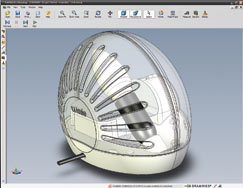
SolidWorks eDrawings are often used to communicate information to China
For Robbins another way of earning respect and ensuring a long and happy working relationship with the factory is to manage expectations very early on. For instance, he will inform the factory that a client is going to do a pilot run of 500, after that they may do a first order of 1,000 and thereafter it could gradually creep up.
With this knowledge the factory will then set their pricing accordingly. Whereas, if you hammered the factory down on price promising an order of 50,000 in the first year but then only ordering 2,000 then everyone is unhappy because the factory has had to squeeze their unit price in order to achieve this.
“Managing expectations of the factory and being really clear about where they are going to make their money is very important. Because if they don’t make money they won’t be there in a year so it’s in our interest to make sure that they are,” comments Robbins.
Strictly confidential
There is always a fear of products being copied and although confidentiality agreements are in place with all suppliers, according to Robbins it really comes down to choosing the right kind of companies to work with.
For instance, the prototyping company that Product Resolutions uses is a pure prototyping company meaning that it doesn’t offer a design service or undertakes manufacturing. “It’s the same with toolmakers,” he says. “Most of the time we use a pure toolmaker rather than a toolmaker that has an assembly factory or an electronics factory. So, our toolmaker will inject the parts and then give them to our assembly partners who only do contract manufacturing. That is one of the ways that you can protect your intellectual property because they simply don’t have the route to market to copy your product.”
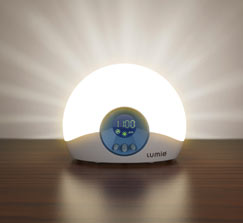
Photorealistic Rendering of the Lumie Starter
Being able to work so efficiently with its Chinese suppliers has also enabled Product Resolutions to have additional income. “Most of our business is fee-based but we have set it up so that we have a mix of different income streams.
It makes the financial side much smoother because in consultancy if you are not working you are not making any money. I hate that, so we get in a situation that if we are not working we still have income coming in from other sources and this works quite well,” he adds.

Prototype of the Lumie Starter
For instance, the company earns commission for introducing a new customer to its Chinese toolmaker. “The factory is happy to pay us commission because they get new business and we are also there in the background to help if there are any problems with communication,” says Robbins.
The road ahead
Product Resolutions is now starting to do more risk and reward type projects where it will either work for reduced fees, or no fee, in return for royalties or part ownership of intellectual property. For instance, this arrangement is in place on a medical product it is currently working on that Robbins has a feeling might do very well.
It’s this unique combination of UK creativity, Chinese technical ability and manufacturing efficiency that is the real hook for Product Resolutions’ clients and keeps them coming back for more. Some future products to look out for include new 2012 Olympics licensed products, a range of audio and video products for up and coming UK brand Veho, a new child safety device and the latest in the range of Lumie Bodyclocks.
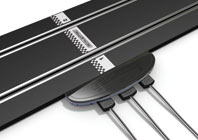
Product Resolutions is hands on in the entire product development process from concept to manufacture

